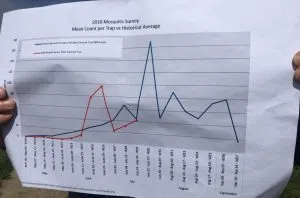This is normally the worst week for mosquitoes in Regina, but the city trap count numbers are slightly below average for this time of year.
Russell Eirich, manager of pest control, horticulture and forestry with the city, said the counts are about 42 mosquitoes per trap and about seven of those — or an average of 15 per cent — are the Culex Tarsalis species which can carry West Nile disease. He said both numbers are within the average range compared to previous years when the counts of the Culex mosquitoes are between 10 and 20 per cent.

Chart showing mosquito counts for 2018 compared to historical average for Regina July 23, 2018. (Adriana Christianson/980 CJME)
Eirich suggested the windy weather has been keeping mosquito populations at bay by drying out standing water quickly after rain.
He said the mosquito populations appear to be much worse outside the city.
“Compared to outside of town, we’re roughly one-fifth of what the population is outside of the control zone, so we’re in good shape right now,” Eirich explained.
The province has raised the risk of transmission of the West Nile virus to moderate across most of central Saskatchewan after some mosquitoes tested positive.
“They’re starting to see some virus in some of the mosquitoes, not in Regina at this point. Do I expect it at some point? Yes, as the summer progresses, they’re going to eventually get into our population as well,” Eirich said.
He noted typically the Culex tarsalis mosquito populations are higher in periods of dry weather.
City deals with one or two wild parsnip plants per summer
Reports of wild parsnip have been on the rise in rural areas across the province, and Eirich said the city typically does get one or two calls about the noxious weed each summer.
This summer, he said the city recently took care of one wild parsnip plant found in a back alley.
The sap of the tall yellow flower increases the skin’s sensitivity to ultraviolet light which can lead to severe blistering and even burns.
Control of noxious weeds is a municipal responsibility, so the city will take care of wild parsnip plants found on public property but can also enforce control of the weed on private property which is the land owner’s responsibility.











